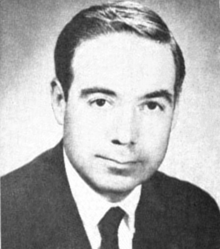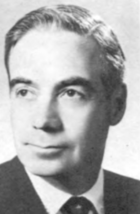William Scranton
William Scranton | |
|---|---|
Governor of Pennsylvania | |
| In office January 15, 1963 – January 17, 1967 | |
| Lieutenant | Raymond P. Shafer |
| Preceded by | David Lawrence |
| Succeeded by | Raymond P. Shafer |
| Member of the U.S. House of Representatives from Pennsylvania's 10th district | |
| In office January 3, 1961 – January 3, 1963 | |
| Preceded by | Stanley Prokop |
| Succeeded by | Joe McDade |
| Personal details | |
| Born | William Warren Scranton July 19, 1917 Madison, Connecticut, U.S. |
| Died | July 28, 2013 (aged 96) Montecito, California, U.S. |
| Political party | Republican |
| Spouse | |
| Children | 4, including William |
| Relatives | Scranton family |
| Education | Yale University (BA, LLB) |
| Military service | |
| Allegiance | United States |
| Branch/service | |
| Years of service | 1941–1945 |
| Rank | |
William Warren Scranton (July 19, 1917 – July 28, 2013) was an American
Born into the prominent
As governor, Scranton presided over sweeping reforms to Pennsylvania's education system, including the creation of the state's
Early life
William Scranton was born on July 19, 1917, while the Scranton family was on vacation at a cottage in Madison, Connecticut.[7] He was the son of Worthington Scranton, a wealthy Pennsylvania businessman who was the president of the Scranton Gas and Water Company, and Marion Margery (Warren) Scranton, a member of the Republican National Committee for over two decades.[8][9] Despite her own involvement in politics, his mother tried to dissuade him from entering politics because of his childhood struggles with asthma. She feared that the stress of campaigning would be detrimental to his frail health. She died just before her son's election to Congress in 1960.
Scranton family members,
Scranton's father was the son of
William Warren Scranton resided with his parents for many years at Marworth, an estate in Dalton, Pennsylvania, that was located roughly eight miles north of Scranton.[12] Following the death of his parents, he inherited the estate. On October 9, 1976, Scranton and his wife hosted a "Day in the Country" party at Marworth. Among the guests in attendance were U.N. Secretary-General Kurt Waldheim and James Murray, British ambassador to the United Nations.[13] In 1981, ground was broken for a new alcohol and drug rehabilitation center to be operated by the Geisinger Medical Management Corporation on the grounds at Marworth.[14]
Education
Scranton began his education at the Scranton Country Day School, which had been founded by his parents, completing his basic schooling at the
Military service
Scranton attended
Early career

Scranton practiced law and then entered the business community after the war becoming successful in several firms in northeastern Pennsylvania. He joined the largest correspondence school in the United States,
Scranton's name recognition and family connections helped him win a 17,000 vote victory over
1962 gubernatorial election
In 1962, the
Governor of Pennsylvania
Economic conditions improved for Pennsylvania residents statewide under Scranton's leadership as "unemployment went from 7.5 percent to 3.6 percent," and the "average blue-collar weekly paycheck increased nearly $23 over the four years," according to the Pittsburgh Post-Gazette. Restricted by state law to just one term as governor during his time in office, Scranton increased state government spending to a then-record $5.21 billion over his term, compared to $3.78 billion by his predecessor."[22] He also signed into law sweeping reforms in the state's education system, which created the state community college system, the state board of education and the state Higher Education Assistance Agency, and he established a program to promote the state in national and international markets and increase the attractiveness of the state's products and services.[23]
The Chester school protests in Chester, Pennsylvania, in the spring of 1964 led by George Raymond of the National Association for the Advancement of Colored People (NAACP) and Stanley Branche of the Committee for Freedom Now (CFFN) against the de facto segregation of public schools prompted Scranton to implement the Pennsylvania Human Relations commission. All protests were discontinued while the commission held hearings during the summer of 1964. Scranton also supported the formation of the Greater Chester Movement, an umbrella organization intended to coordinate activities of groups working toward the betterment of Chester [24]
While he was governor, the largest manhunt in the history of Pennsylvania until then took place. On May 11, 1966,
1964 presidential election

Although Scranton did not actively seek the 1964 Republican nomination for President of the United States in the beginning, a "Draft Scranton" movement quickly gathered momentum among moderate and liberal Republicans who saw him as an alternative to conservative frontrunner, Senator Barry Goldwater, and other Republicans who feared that Goldwater's polarizing views would lead to defeat, after the campaign of Goldwater's liberal opponent, New York governor Nelson Rockefeller, had lost steam. Early in the campaign, he announced that he would be willing to accept the nomination for Vice President. Scranton first declined to enter the race but later threw his hat into the ring on June 12, 1964. Scranton won the support of ten state delegations, but Goldwater went on to win the nomination on the first ballot.[25] Republican National Committee Chairman and US Representative William E. Miller of New York was nominated for Vice President.[26]
Later career

Under the then-existing Pennsylvania law, Scranton was limited to a single term and could not run for reelection in
After the
Following Nixon's resignation from the Presidency in 1974, he was appointed as a transition team member for incoming President Gerald Ford.[29]

Scranton reentered the business world and served on the boards of several high-profile American corporations such as
In 1976, Scranton was chosen by President Ford to become
Scranton's son,
Scranton was elected to the American Philosophical Society in 1997.[34]
Death
Nine days after his 96th birthday, Scranton died on July 28, 2013, from a cerebral hemorrhage at a retirement community in Montecito, California, where he lived with his wife.[35][36] His widow, Mary Scranton, the former First Lady of Pennsylvania, died from Alzheimer's disease on December 26, 2015, at the age of 97.[37]
In popular culture
In Jeff Greenfield's alternate history book If Kennedy Lived, Scranton is featured as Senator Barry Goldwater's running mate in the 1964 presidential election, instead of William E. Miller.
See also
References
- ^ McFadden, Robert D. “William W. Scranton, 96, G.O.P. Prodigy Who Led Pennsylvania, Is Dead.” New York, New York: The New York Times, July 29, 2013 (retrieved online, June 3, 2021).
- ^ “Governor William Warren Scranton” (biography), in “Governors.” Harrisburg, Pennsylvania: Pennsylvania Historical and Museum Commission, retrieved online, June 3, 2021.
- ^ McNulty, Timothy. “Former Pennsylvania governor William Scranton Jr. dies.” Pittsburgh, Pennsylvania: Pittsburgh Post-Gazette, July 30, 2013 (retrieved online, June 3, 2021).
- ^ Carocci, Vincent P. Capitol Journey: Reflections on the Press, Politics, and the Making of Public Policy in Pennsylvania, Chapter 13: “William Warren Scranton II (1963-1967).” University Park, Pennsylvania: The Pennsylvania State University Press, 2005.
- ^ Baer, John. “An elegant man (and politician) passes: William Warren Scranton was many things rarely seen in politics today.” Philadelphia, Pennsylvania: The Philadelphia Inquirer, July 30, 2013 (retrieved online, June 3, 2021).
- ^ White, Theodore H. “Squire Scranton Bides His Time.” New York, New York: Life, February 28, 1964, pp. 63-72 (retrieved online, June 3, 2021).
- ^ Perlstein, Rick. Before the Storm: Barry Goldwater and the Unmaking of the American Consensus, p. 275. New York, New York: Hill and Wang, A Division of Farrar, Straus and Giroux, 2001.
- ^ O’Malley III, Michael J. “The Gentleman from Pennsylvania: An Interview with William W. Scranton,” in Pennsylvania Heritage, Winter 2001. Harrisburg, Pennsylvania: Pennsylvania Historical and Museum Commission, retrieved online June 3, 2021.
- ^ "The Political Graveyard: Scranton family of Scranton, Pennsylvania".
- ^ White, Theodore H. “Squire Scranton Bides His Time," Life, February 28, 1964, pp. 63-72.
- Scranton Republican, December 6, 1916.
- ^ “Mrs. Marion Margery Scranton Dies,” The Scranton Tribune, June 24, 1960.
- ^ "Fulton, Brian. "Who's who of the United Nations parties at Marworth estate." Scranton, Pennsylvania: The Times-Tribune, October 24, 2018, p. G15.
- ^ "Marworth Project" (photo essay). Scranton, Pennsylvania: Scrantonian Tribune, October 25, 1981, p. 113.
- ^ “Governor William Warren Scranton” (biography), in “Governors," Pennsylvania Historical and Museum Commission.
- ^ "Yale Library". Retrieved 14 August 2016.
- ^ “Governor William Warren Scranton” (biography), in “Governors," Pennsylvania Historical and Museum Commission.
- ^ “Governor William Warren Scranton” (biography), in “Governors," Pennsylvania Historical and Museum Commission.
- ^ “Governor William Warren Scranton” (biography), in “Governors," Pennsylvania Historical and Museum Commission.
- ^ Carocci, Vincent P. Capitol Journey: Reflections on the Press, Politics, and the Making of Public Policy in Pennsylvania, Chapter 13: “William Warren Scranton II (1963-1967)," The Pennsylvania State University Press, 2005.
- ^ “Governor William Warren Scranton” (biography), in “Governors," Pennsylvania Historical and Museum Commission.
- ^ McNulty, Timothy. “Former Pennsylvania governor William Scranton Jr. dies," Pittsburgh Post-Gazette, July 30, 2013.
- ^ White, Theodore H. “Squire Scranton Bides His Time," Life, February 28, 1964, pp. 63-72.
- ISBN 978-1-4798-6609-0. Retrieved 28 October 2018.
- ^ Carocci, Vincent P. Capitol Journey: Reflections on the Press, Politics, and the Making of Public Policy in Pennsylvania, Chapter 13: “William Warren Scranton II (1963-1967),” The Pennsylvania State University Press, 2005.
- ^ “Governor William Warren Scranton” (biography), in “Governors," Pennsylvania Historical and Museum Commission.
- ^ “Governor William Warren Scranton” (biography), in “Governors," Pennsylvania Historical and Museum Commission.
- ^ “Governor William Warren Scranton” (biography), in “Governors," Pennsylvania Historical and Museum Commission.
- ^ “Governor William Warren Scranton” (biography), in “Governors," Pennsylvania Historical and Museum Commission.
- ^ O’Malley III, Michael J. “The Gentleman from Pennsylvania: An Interview with William W. Scranton,” in Pennsylvania Heritage, Winter 2001, Pennsylvania Historical and Museum Commission.
- ^ Carocci, Vincent P. Capitol Journey: Reflections on the Press, Politics, and the Making of Public Policy in Pennsylvania, Chapter 13: “William Warren Scranton II (1963-1967),” The Pennsylvania State University Press, 2005.
- ^ O’Malley III, Michael J. “The Gentleman from Pennsylvania: An Interview with William W. Scranton,” in Pennsylvania Heritage, Winter 2001, Pennsylvania Historical and Museum Commission.
- ^ Carocci, Vincent P. Capitol Journey: Reflections on the Press, Politics, and the Making of Public Policy in Pennsylvania, Chapter 13: “William Warren Scranton II (1963-1967),” The Pennsylvania State University Press, 2005.
- ^ "APS Member History". search.amphilsoc.org. Retrieved 2021-12-09.
- ^ "FORMER PA. GOVERNOR, PRESIDENTIAL CANDIDATE DIES". AP. Archived from the original on 30 July 2013. Retrieved 30 July 2013.
- ^ Krawczeniuk, Boris. “William Warren Scranton: The reluctant giant.” Scranton, Pennsylvania: The Times-Tribune, July 29, 2013 (retrieved online, June 3, 2021; subscription required).
- ^ O'Connell, Jon (2015-12-28). "Former Pennsylvania first lady Mary L. Scranton, 97, dies". The Citizens' Voice. Retrieved 2015-12-30.
External links
- United States Congress. "William Scranton (id: S000193)". Biographical Directory of the United States Congress.
- Appearances on C-SPAN




